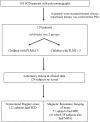Association Between Periodic Limb Movements in Sleep and Cerebrovascular Changes in Children With Sickle Cell Disease
- PMID: 31383239
- PMCID: PMC6622511
- DOI: 10.5664/jcsm.7884
Association Between Periodic Limb Movements in Sleep and Cerebrovascular Changes in Children With Sickle Cell Disease
Abstract
Study objectives: Periodic limb movements (PLMs) have been associated with increased risk of stroke, but there is currently scarce research exploring this relationship in the setting of sickle cell disease (SCD). The aim of this study was to explore whether increased PLMs in children with SCD are associated with increased risk of cerebrovascular disease and to determine if there are any clinical or laboratory differences between children with SCD with elevated periodic limb movement index (PLMI) versus those with normal PLMI.
Methods: This study is a comprehensive review of medical records of 129 children with SCD (aged ≤ 18 years) who had undergone polysomnography for evaluation of sleep-disordered breathing.
Results: Elevated PLMI (PLMI > 5 events/h) was present in 42% (54/129) of children with SCD. Children with elevated PLMI were found to have higher percentage of hemoglobin S, lower total iron, higher arousal index and tendency toward elevated transcranial Doppler velocity (P = .063, odds ratio = 3.9, 95% CI 0.93-16.22). While association between elevated PLMI and isolated cerebrovascular stenosis (P = .050, odds ratio 5.6, 95% CI 1.0-31.10) trended toward significance, there was significantly greater proportion of children with elevated PLMI who had cerebrovascular stenosis with Moyamoya disease (P = .046) as demonstrated by magnetic resonance imaging (MRI).
Conclusions: The prevalence of elevated PLMI in children with SCD was higher than in previously published data. Elevated PLMI was significantly associated with greater rates of cerebrovascular disease as detected by MRI.
Keywords: cerebrovascular disease; children; magnetic resonance imaging; periodic limb movements in sleep; polysomnography; sickle cell disease; transcranial doppler.
Copyright © 2019 American Academy of Sleep Medicine. All rights reserved.
Figures


Similar articles
-
Periodic limb movements of sleep are associated with an increased prevalence of atrial fibrillation in patients with mild sleep-disordered breathing.Int J Cardiol. 2017 Aug 15;241:200-204. doi: 10.1016/j.ijcard.2017.04.060. Epub 2017 Apr 22. Int J Cardiol. 2017. PMID: 28457559
-
Prevalence of periodic limb movements during sleep in normal children.Sleep. 2014 Aug 1;37(8):1349-52. doi: 10.5665/sleep.3928. Sleep. 2014. PMID: 25083015 Free PMC article.
-
Comorbidities in children with elevated periodic limb movement index during sleep.Sleep. 2020 Feb 13;43(2):zsz221. doi: 10.1093/sleep/zsz221. Sleep. 2020. PMID: 31555831
-
Prevalence of periodic limb movement in sleep in people with epilepsy: A semi-structured literature review.Epilepsy Behav. 2021 Mar;116:107721. doi: 10.1016/j.yebeh.2020.107721. Epub 2021 Jan 22. Epilepsy Behav. 2021. PMID: 33493804 Review.
-
The effects of periodic limb movements in sleep (PLMS) on cardiovascular disease.Heart Lung. 2013 Sep-Oct;42(5):353-60. doi: 10.1016/j.hrtlng.2013.07.006. Heart Lung. 2013. PMID: 23998383 Review.
Cited by
-
Movement Disorders and Hematologic Diseases.Mov Disord Clin Pract. 2020 Dec 29;8(2):193-207. doi: 10.1002/mdc3.13129. eCollection 2021 Feb. Mov Disord Clin Pract. 2020. PMID: 33553488 Free PMC article. Review.
References
-
- Centers for Disease Control and Prevention website. Data & Statistics on Sickle Cell Disease. [Accessed May 10, 2018]. https://www.cdc.gov/ncbddd/sicklecell/data.html.
-
- Rees DC, Williams TN, Gladwin MT. Sickle-cell disease. Lancet. 2010;376(9757):2018–2031. - PubMed
-
- Platt OS. Preventing stroke in sickle cell anemia. N Engl J Med. 2005;353(26):2743–2745. - PubMed
MeSH terms
LinkOut - more resources
Full Text Sources
Medical

